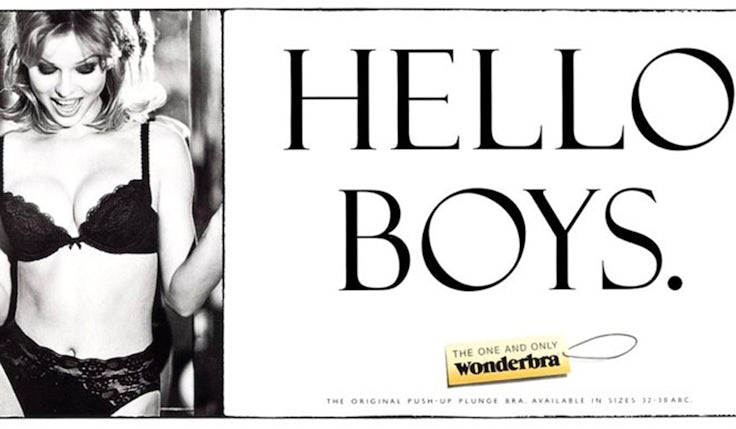What the evolution of Wonderbra tells us about ‘brave’ marketing campaigns
The ‘Hello Boys’ campaign has long been held up as a classic by those who want to take marketing back to what they see as a ‘braver’ time – but, in reality, it was little more than a lazy effort that forgot to speak to its target audience.
 Who knew earlier this month there was an International No Bra Day? Very few of us, I’m guessing. But there was, and it’s a thing. A wonderful thing.
Who knew earlier this month there was an International No Bra Day? Very few of us, I’m guessing. But there was, and it’s a thing. A wonderful thing.
Of course, the words ‘wonderful’ and ‘bra’ in the same sentence can’t help but transport anyone over a certain age back to when, 30 years ago, Wonderbra launched its famous (and infamous) ‘Hello Boys’ marketing blitz in the UK.
Whatever one thinks about the campaign – whose less well-known taglines also included ‘Or are you just pleased to see me?’ and ‘Look me in the eyes and tell me that you love me’ – it was considered a huge success for the brand, going on to win a coveted IPA Effectiveness Award among other accolades.
In 2020, Nigel Rose, then creative director at the ad agency behind the work, described the campaign as “of its time”, hinting that the billboards weren’t only considered acceptable back then but were very much in step with culture. But were they?
The argument that advertising today lacks guts is one we often hear, particularly when purpose-fuelled campaigns are being criticised.
Remember, 1994 was also the year that the Church of England finally allowed women to be ordained as priests, and the depreciatingly named ‘Women’s Royal Airforce’ was merged into the Royal Airforce in recognition of women’s equal contribution to the service. Maybe culture was shifting more quickly than advertising could keep up with.
But then you come back to the sales results, which, for those in the camp that marketing is first and foremost a tool for measurable financial impact versus a vehicle for broader social goals, say it all.
Powering through is no longer an option, it’s time to make change happenIt was interesting chatting with one of our female creatives, a few years younger than me, who recently described Wonderbra’s 30-year-old creative idea as “okay at best, I guess, but actually just very lazy”, adding, “honestly, it’s much easier to objectify women than it is to think of an idea which speaks to and benefits them.”
I love the clarity of her point of view – a snappy retort to those who (secretly?) believe the campaign was the epitome of bravery, a prime example of an era when marketing was supposedly far more open to risk-taking than it is today.
The argument that advertising today lacks guts is one we often hear, particularly when purpose-fuelled campaigns are being criticised. But isn’t it more about needing to find a middle ground? Less shallowness and provocation for the sake of it; more adding value to consumers’ lives. And all the while wrapping things up in a brilliant creative idea.
But getting this balance right is incredibly hard. Take Wonderbra’s 2018 iteration of the original campaign, updated for our more purposeful times with the line ‘Hello Me’, which somehow offended me even more. On the one hand, and from a professional point of view, it came over as a watered-down version of the original, which, despite its faults, at least had swagger. On the other, and personally speaking, linking ‘me’ with a fulsome, ‘better’ cleavage felt reductive in a wholly new, yet even more insidious way than its 1994 forerunner.
Fast forward to 2024 and the Canadian-born bra brand’s 85th anniversary. I’ve not seen a major campaign from it, but there is a spot running on social that feels as if it’s nudging closer to a more fitting, optimistic territory for the brand. It aims to support women, subtly hinting at a shared battle for our rights and reminding us of our collective female experiences. Yes, it lacks a big creative idea, and it certainly isn’t going to cause any car crashes, but it has far more warmth than Eva Herzigová in her undies.
And there you have it. Wonderbra as a textbook example of a brand navigating changing times and shifting social norms. From creative ‘bravery’ in the 90s (and, ahem, male creative directors who dominated the industry) to what amounted to an apology ad in the 2010s and on to today’s more inclusive, body-positive approach. It’s a fascinating journey.
Brands don’t need to choose between playfulness and purpose – they can do bothOne final thought I’ll leave you with. Despite all the noise around the 1994 campaign and claims that the brand’s uptick in sales could be tied directly back to the campaign, the truth is that between 1991 and 1993, UK sales of the Wonderbra style had already quadrupled to £21m. No doubt inspired by a Vivienne Westwood-led fad for corsetry and fashion wunderkind Jean-Paul Gaultier’s popularisation of underwear as outerwear. In one sense, that reality somewhat lets the people behind the Hello Boys campaign off the hook, they weren’t the only ones responsible for girls’ boob anxieties in the 1990s.
In another sense, though, it’s a reminder that while, as an industry, we like to think breakout advertising shapes the world in which we live, plenty of other cultural factors are at play at any given time.
Here’s to truly syncing with emerging – as well as dominant – culture to deliver meaningful work that adds value, inspires and moves people. And to never taking the lazy route.






